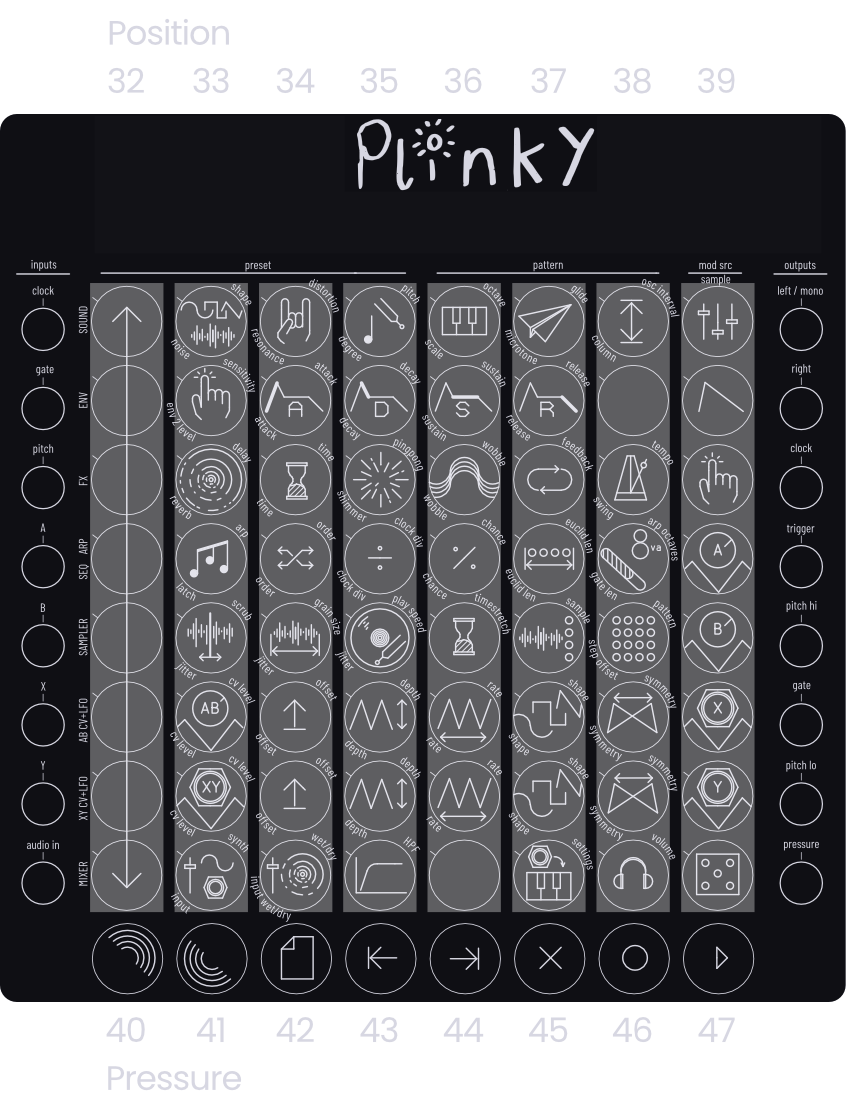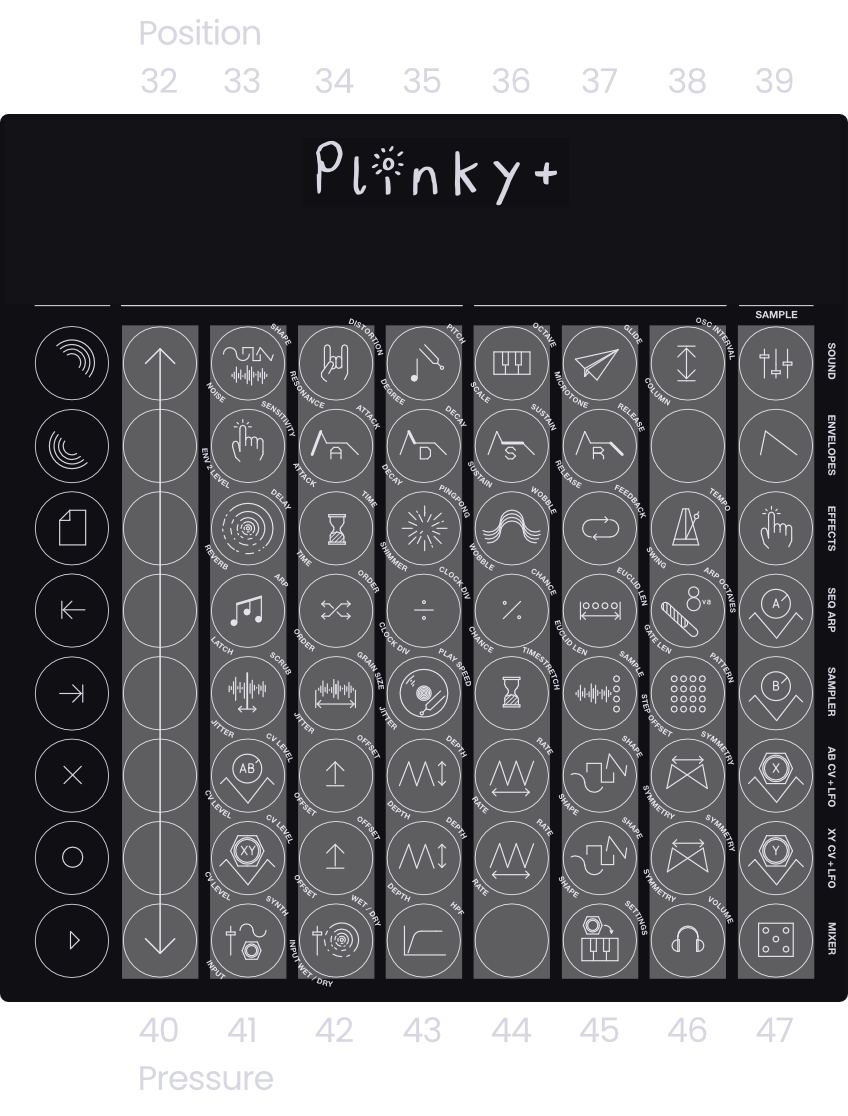General
Plinky responds to MIDI!
TRS MIDI
On Plinky V3 the MIDI jacks are the leftmost two jacks next to the Audio I/O and the bottom USB port.
- The TRS MIDI input is the leftmost TRS jack. The input accepts TRS MIDI Type A or B.
- The TRS MIDI output is the second TRS jack from the left. The output is TRS MIDI Type A (Korg).
On Plinky+ the MIDI jacks are located on the back panel.
- The TRS MIDI input is located next to the USB jack and can be either Type A or B.
- The TRS MIDI output is next to the power switch and is TRS MIDI Type A (Korg).
On Plinky V1 and V2, you can add TRS MIDI with the 2HP Expander.
The input circuit used on all versions is the LPZW.modules Autocrossover circuit. Thank you Kay!
USB MIDI
If you connect Plinky to a computer with a USB cable, it will create a MIDI Port as plinkysynth. Plinky will then act as an 8-voice synthesizer. It acts as USB a client, so you need to connect it to your computer or another MIDI host to use the port. Plinky has polyphonic MIDI Note Input and Output.
Input
Plinky responds to incoming notes, as well as MIDI Control Changes (CC). These allow you to edit a subset of Plinky's parameters via MIDI in real time. You can play Plinky while MIDI is being sent to it. Plinky will prioritise touch input over MIDI input, so you can jam over a pre-recorded MIDI pattern.
Output
Plinky sends polyphonic aftertouch, as well as pressure and position as MIDI Control Changes (CC) for each of its strings.
Set MIDI Input and Output channels
Plinky sends and listens to MIDI channel 1 by default.
To set the MIDI I/O channels, use the unprinted pad in the bottom row.
hold
tap
To change the MIDI input channel, you hold down the shift top button, and while holding it down, select one the unprinted pad. Use the Encoder to select the MIDI input channel, ranging from 1 - 16.
hold
tap
To change the MIDI output channel, you hold down the shift bottom button, and while holding it down, select one the unprinted pad. Use the Encoder to select the MIDI output channel, ranging from 1 - 16.
This setting is stored with each patch. That means you can set and recall it individually for each preset.
MIDI CCs - Input
Here's a list of all the CC parameters that Plinky listens to.
Oscillator
| CC | Parameter |
|---|---|
| 13 | Shape |
| 4 | Distortion |
| 9 | Pitch |
| 14 | Interval |
| 2 | Noise level |
| 5 | Glide |
| 71 | Resonance |
Arpeggiator
| CC | Parameter |
|---|---|
| 101 | Latch |
| 102 | On/off |
| 103 | Order |
| 104 | Clock division |
| 105 | Chance |
| 106 | Euclid length |
| 107 | Octaves |
Sequencer
| CC | Parameter |
|---|---|
| 108 | Order |
| 109 | Clock division |
| 110 | Chance |
| 111 | Euclid length |
| 11 | Gate length |
| 83 | Pattern |
| 85 | Steps |
Envelope 1
| CC | Parameter |
|---|---|
| 3 | Sensitivity (LPF amount) |
| 73 | Attack |
| 74 | Sustain |
| 75 | Decay |
| 72 | Release |
Envelope 2
| CC | Parameter |
|---|---|
| 19 | Level |
| 20 | Attack |
| 21 | Decay |
| 22 | Sustain |
| 23 | Release |
FX - Delay
| CC | Parameter |
|---|---|
| 94 | Delay send amt |
| 12 | Delay time |
| 112 | Delay pingpong |
| 113 | Delay wobble |
| 95 | Delay feedback amt |
Modulation A B
| CC | Parameter |
|---|---|
| 24 | A Rate |
| 25 | A Depth |
| 26 | A Offset |
| 27 | B Rate |
| 28 | B Depth |
| 29 | B Offset |
Modulation X Y
| CC | Parameter |
|---|---|
| 76 | X Rate |
| 77 | X Depth |
| 78 | X Offset |
| 79 | Y Rate |
| 80 | Y Depth |
| 81 | Y Offset |
FX - Reverb
| CC | Parameter |
|---|---|
| 91 | Reverb send amt |
| 92 | Reverb time |
| 93 | Reverb shimmer |
| 114 | Reverb wobble |
Sampler
| CC | Parameter |
|---|---|
| 15 | Scrub |
| 16 | Grain size |
| 17 | Play speed |
| 18 | Timestretch |
| 82 | Sample |
Sampler Jitter
| CC | Parameter |
|---|---|
| 116 | Jitter position |
| 117 | Jitter grain size |
| 118 | Jitter rate |
Mixer
| CC | Parameter |
|---|---|
| 89 | External In Volume |
| 90 | External In Wet / Dry |
| 31 | HPF amount |
| 7 | Synth Level |
| 8 | Wet / Dry |
Midi CCs - Output
Plinky supports MIDI out over USB and TRS (since hardware v3, or if you have the Expander).
Plinky’s implementation has polyphonic aftertouch.
In addition to that,
- the finger position for each column is sent on CC 32 - 39,
- and the pressure for each column is sent on CC 40 - 47.


